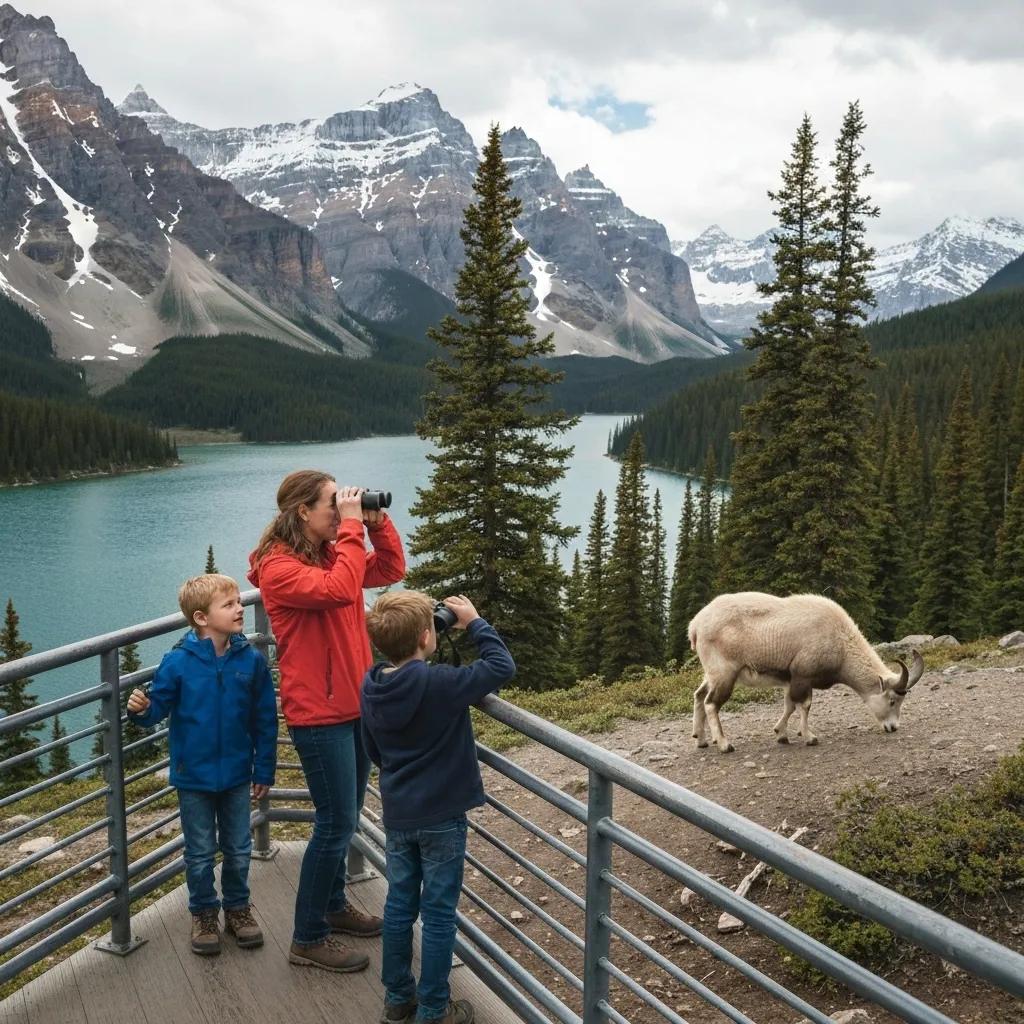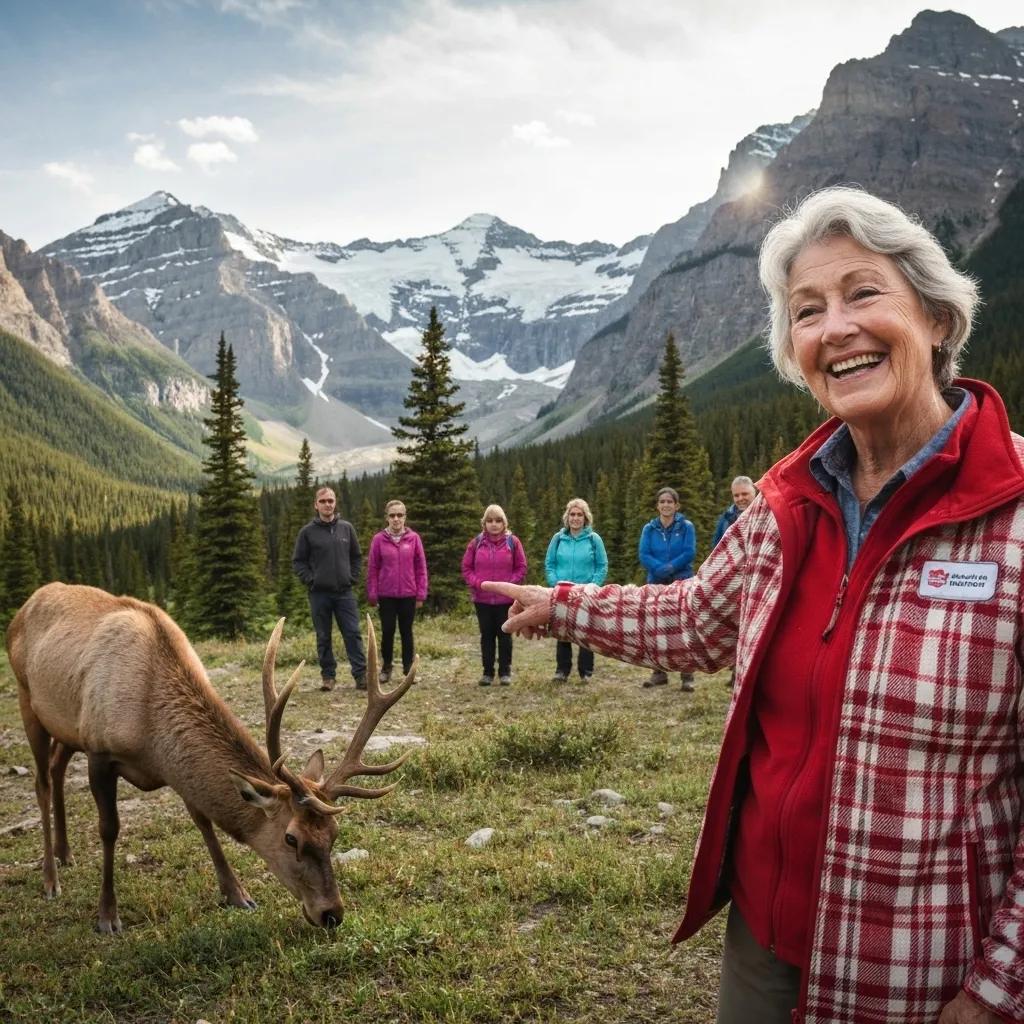
Wildlife in Banff: What Animals You Might See and How to Spot Them Safely
Banff National Park’s rugged peaks and pristine meadows host an astonishing array of wildlife, drawing visitors eager to witness grizzly bears, elk herds, and soaring eagles in their natural habitat. Understanding where animals live, when they’re most active, and how to observe them without risk transforms a simple sightseeing trip into a once-in-a-lifetime encounter. This comprehensive guide on wildlife in Banff outlines core species, prime viewing spots, seasonal patterns, safety essentials, responsible tourism practices, and the advantages of expert-led excursions. Whether you’re weighing self-guided exploration or considering a guided tour with Banff Day Trips, you’ll find actionable insights to plan a safe, sustainable, and memorable adventure.
What Animals Live in Banff National Park?
Banff National Park encompasses montane forests, alpine tundra, and glacial valleys that support mammals, birds, and smaller predators year-round. These ecosystems blend to create niches where each species thrives, from riverbanks to rocky ridges. Exploring this diversity clarifies why Banff is heralded as one of the most biodiverse parks in the Canadian Rockies.
Which Large Mammals Are Commonly Seen in Banff?
Among the most iconic large mammals in Banff are grizzly bears, black bears, elk, moose, and bighorn sheep. These species occupy different elevations and foraging areas, offering varied viewing experiences.
- Grizzly Bear: Found in subalpine meadows, forage for roots and berries.
- Black Bear: Common along forest edges, omnivorous habits include berries and insects.
- Elk: Thrive in montane meadows and valley bottoms, especially during dawn and dusk.
- Moose: Inhabit wetlands and lakeshores, feeding on aquatic plants.
- Bighorn Sheep: Navigate rocky slopes, grazing on grasses and alpine forbs.
Elk Behavior and Safety in Banff National Park
Parks Canada advises visitors to maintain a minimum distance of 30 meters from elk, especially during the fall rutting season (late August to mid-October) when bull elk can be aggressive, and the spring calving season (mid-May to early July) when female elk are highly defensive of their young. Approaching elk too closely can provoke aggressive behavior, including charges with hooves or antlers.
Source: Parks Canada, Banff National Park Official Website, 2022-2025
What Bird Species Can You Spot in Banff?
Banff’s waterways and cliffs draw raptors and songbirds that enliven skies and treetops with color and call.
- Bald Eagle: Patrols lakeshores and rivers, diving for fish.
- Golden Eagle: Soars over mountain ridges, preying on small mammals.
- Osprey: Nests near open water, skilled at plunging dives.
- Great Horned Owl: Roosts in forest canopies, active at dusk and night.
- White-tailed Ptarmigan: Occupies alpine tundra, camouflaged against snow.
Which Smaller Mammals and Predators Inhabit Banff?
Beyond the giants, Banff’s valleys shelter wolves, coyotes, lynx, mountain goats, marmots, and pikas, each adapted to niche environments.
- Wolf: Packs roam forest edges and meadows in search of ungulate prey.
- Coyote: Versatile hunters frequent open terrain and park corridors.
- Lynx: Elusive nocturnal felines stalk snowshoe hares in dense forests.
- Mountain Goat: Climbs steep cliffs, browsing alpine grasses.
- Marmot: Hibernates in burrows, alerts hikers with whistle-like calls.
- Pika: Collects grasses among talus slopes, often heard before seen.
How Do Animal Habitats Vary Across Banff’s Landscapes?
Below is a comparison of Banff’s primary landscapes, their key habitat traits, and representative wildlife.
| Landscape Type | Habitat Characteristics | Species Example |
|---|---|---|
| Montane Forest | Dense spruce and pine stands | Black Bear |
| Subalpine Meadows | Wildflower fields at tree line | Grizzly Bear |
| Alpine Tundra | Wind-swept, sparse vegetation | White-tailed Ptarmigan |
| Wetlands & Lakeshores | Shallow water zones with aquatic plants | Moose |
| Rocky Slopes | Exposed cliffs and talus fields | Bighorn Sheep |
Where Are the Best Places to See Wildlife in Banff?
What Wildlife Can You See Along the Bow Valley Parkway?
The Bow Valley Parkway stretches 48 km between Banff and Lake Louise, where early morning and late afternoon drives often reveal elk herds grazing roadside meadows, black bears foraging on berry bushes, and coyotes patrolling for small mammals. Increasing your noise level while moving reduces surprise encounters, and pullouts provide safe vantage points for photography.
Which Animals Frequent Lake Minnewanka and Moraine Lake Areas?
Lake Minnewanka’s open water attracts moose feeding on submerged vegetation and osprey fishing along the shoreline, while forest edges may yield sightings of mule deer and occasional bears. Moraine Lake’s high-elevation position draws mountain goats scaling cliffs and white-tailed ptarmigan blending into talus fields. Planning a canoe trip opens additional wildlife perspectives from the lake surface.
How Does Icefields Parkway Offer Unique Wildlife Viewing Opportunities?
Icefields Parkway, one of the world’s most scenic drives, links Banff and Jasper National Parks with high alpine passes and glacial viewpoints. Seasonal highlights include grizzly bear sightings in summer, bighorn sheep on rocky ledges in spring, and thinhorn sheep congregating in lower valleys during winter migration. The juxtaposition of glaciers and wildlife makes every stop a potential wildlife vantage.
What Are Other Prime Wildlife Viewing Spots in Banff?
- Two Jack Lake: Family of river otters and migratory waterfowl.
- Sulphur Mountain: Rocky habitats attract bighorn sheep and marmots.
- Vermilion Lakes: Beaver lodges, moose feeding at water’s edge.
How Can You Spot Wildlife Safely in Banff National Park?
Observing animals responsibly ensures both human security and wildlife welfare, preserving natural behaviors and minimizing conflict.
What Are the Essential Wildlife Viewing Safety Guidelines?

Before each outing, visitors should:
- Maintain a minimum 100 m distance from bears and wolves.
- Use binoculars or telephoto lenses to observe without approaching.
- Store food in bear-resistant containers or lockers.
- Hike in groups and make periodic noise to announce presence.
- Never feed, harass, or attempt to touch wildlife.
Human-Wildlife Conflict Patterns in Banff National Park
Research on human-wildlife conflicts in Banff National Park between 2008 and 2016 revealed that a significant majority (96%) of incidents occurred within 1 km of trails or roads. Conflicts were primarily linked to townsite activities and driving, highlighting the impact of human presence on wildlife behavior and the importance of maintaining distance.
Source: Li, Y., The University of British Columbia, 2020
How and When Should You Use Bear Spray in Banff?
Bear spray offers a non-lethal deterrent for close encounters with bears. Always carry it visibly on your belt, remove the safety clip near areas of known bear activity, and practice deploying it before entering the backcountry. Discharge the canister downward to create a cloud between you and the animal when a bear approaches within 10 m. Proper training enhances confidence and effectiveness in high-adrenaline situations.
What Should You Do If You Encounter a Bear or Other Wildlife?
If you spot a bear at a distance, calmly retreat along the same path without turning your back. Should a bear approach you directly, stand your ground, wave your arms, speak firmly, and deploy bear spray if within range. In the case of an aggressive charge, drop to the ground in a fetal position if it’s a defensive attack; stand tall and fight back if it’s predatory. These protocols vary slightly between grizzly and black bear encounters, so reviewing park guidelines before hiking is essential.
Why Is Responsible Wildlife Viewing Important for Safety and Conservation?
Respecting animal space maintains natural behavior patterns, reduces habituation risk, and protects visitors from injury. Ethical viewing also supports conservation goals by minimizing human footprint and reinforcing Banff National Park’s mission to safeguard wildlife for future generations. Embracing this ethic enhances every wildlife experience without compromising park values.
When Is the Best Time to See Wildlife in Banff?
What Wildlife Is Active in Spring?
As snow recedes, bears emerge from hibernation and migratory birds return to nesting grounds. Early spring sightings often include grizzly and black bears feeding on fresh shoots, elk calves born in late spring, and waterfowl nesting along thawing lakeshores.
Which Animals Are Most Visible in Summer?
Summer brings abundant plant growth, attracting elk, deer, and moose to higher meadows. Young mammals such as mountain goat kids and bighorn sheep lambs appear, while ospreys and eagles patrol open water. Extended daylight hours increase viewing windows for both dawn and dusk activity.
How Does Fall Affect Wildlife Viewing?
With cooling temperatures, elk enter their rutting season, making Bow Valley and Banff townsite meadows ideal for observing bugling bulls and sparring males. Migratory waterfowl concentrate on Vermilion Lakes, and bears forage intensively to build fat reserves before hibernation.
What Wildlife Can You Spot in Winter?
Winter’s stark landscape favors hardy residents like wolf packs tracking elk across snowfields and lynx following snowshoe hares in dense forest. Tracks in snow reveal hidden activity, and observing from heated parkways or guided snowshoe tours ensures safe, comfortable wildlife encounters.
What Are the Benefits of Guided Wildlife Tours in Banff?

How Do Expert Guides Enhance Wildlife Viewing and Safety?
Local guides know animal movement patterns, secret vantage points, and subtle signs such as scat or tracks. Their knowledge reduces time spent searching, increases sighting success, and ensures adherence to safety protocols, making every outing both secure and insightful.
What Types of Wildlife Tours Does Banff Day Trips Offer?
Banff Day Trips provides private Tours | custom itineraries for groups up to 12 people, seasonal wildlife focus outings, and small-group departures that balance personalized attention with social camaraderie. Private tours allow flexible timing and targeted species searches, while small-group options offer cost-effective wildlife adventures. For full details on personalized wildlife experiences, explore their Private Tours.
How Do Guided Tours Ensure Responsible and Safe Wildlife Encounters?
Professional guides carry bear spray, maintain mandated distances, communicate park regulations, and carry emergency equipment. They educate on Leave No Trace principles during hikes and provide context on animal ecology, ensuring that wildlife observation aligns with conservation goals.
What Can You Expect on a Typical Banff Wildlife Tour?
A standard wildlife tour includes early-morning pickups, binocular and spotting scope use, trek to prime habitats such as Bow Valley Parkway or Lake Minnewanka, wildlife interpretation breaks, and photo stops. Tours run 4–8 hours and conclude with a debrief on sightings and best practices for self-guided outings.
How Can You Practice Responsible Wildlife Tourism in Banff?
What Are the Leave No Trace Principles for Wildlife Viewing?
- Travel and camp on durable surfaces to avoid habitat damage.
- Dispose of waste properly, including food scraps and packaging.
- Leave natural objects—and wildlife—in place without disturbance.
- Minimize noise to prevent stressing sensitive species.
- Observe wildlife only from safe, approved distances.
What Are Banff National Park’s Regulations for Wildlife Protection?
Banff enforces strict rules: no feeding wildlife, mandatory food storage in bear-proof lockers, and fines for disturbing animals. Off-trail travel near sensitive habitats may be restricted seasonally to protect breeding grounds. Compliance supports the park’s conservation mission.
How Does Human Presence Affect Banff’s Wildlife?
Frequent human activity can habituate animals to people, increasing risk of conflict and disrupting natural behaviors like foraging or mating. Responsible distancing and minimal interference reduce stress on wildlife, promoting healthy populations over time.
Impact of Human Activity on Carnivore Movement and Habitat in the Bow Valley
A peer-reviewed study published in Movement Ecology in April 2022, utilizing GPS collar data from 34 grizzly bears and 33 wolves (2000–2020), found that large carnivores like grizzly bears and wolves increase their travel speed near towns and high-density trail/road areas to avoid human encounters. The study concluded that current development has reduced high-quality habitat for connectivity by an average of 85% in the Banff-Bow Valley, with wolves showing stronger avoidance than grizzly bears.
Source: Whittington, J., Hebblewhite, M., et al., Movement Ecology, 2022
What Are Common Questions About Banff Wildlife and Safety?
What Kind of Wildlife Is in Banff National Park?
Banff National Park hosts over 50 mammal species—including grizzly bears, elk, moose, wolves—and more than 260 bird species ranging from bald eagles to ptarmigan, plus numerous small mammals and amphibians.
Where Can I See Wildlife Safely in Banff?
Safe wildlife viewing typically occurs along established corridors such as Bow Valley Parkway, Lake Minnewanka, Icefields Parkway, and Vermilion Lakes. Using pullouts, staying in vehicles, or joining guided tours further reduces risk.
Is It Safe to Walk in Banff at Night Because of Bears?
Walking alone after dark is discouraged. While bears and other wildlife may be active, carrying bear spray, traveling in groups, and making noise mitigates surprise encounters. For night excursions, guided tours offer added protection.
What Is the Best Time of Year to See Bears in Banff?
Bear activity peaks in spring as they emerge from hibernation and again in late summer and early fall when foraging intensifies. May through June and August through September yield the highest sighting probability.
Are There Wolves in Banff National Park?
Yes. Wolf packs inhabit Banff’s forests and valleys, often tracking elk herds. Sightings are less common than ungulates but increase in winter when ungulates congregate in open valleys.
How Can You Book the Best Wildlife Tours in Banff?
What Should You Look for When Choosing a Banff Wildlife Tour?
Prioritize small-group sizes, certified wildlife guides, flexible itineraries, included safety equipment, and transparent pricing. Operators with strong conservation commitments and positive reviews demonstrate reliability and expertise.
How Do Private Wildlife Tours Differ from Group Tours?
Private tours offer personalized schedules, focused species searches, and exclusive interactions, while group tours share resources across a broader audience, providing social dynamics and often lower per-person costs.
Where Can You Find Reviews and Ratings for Banff Wildlife Tours?
Traveler testimonials on TripAdvisor highlight real experiences, guide professionalism, and wildlife sightings. For an in-depth review of Banff Day Trips’ offerings, see this TripAdvisor review.
How to Prepare for Your Banff Wildlife Tour?
Pack layered clothing suitable for variable mountain weather, sturdy hiking boots, binoculars, a camera with a zoom lens, water, snacks stored in sealed containers, and basic first-aid supplies. Early starts and light breakfasts optimize wildlife activity windows.
Banff’s wildlife richness, from towering grizzlies to alpine ptarmigan, invites exploration tempered by respect and preparation. By following safety protocols, choosing knowledgeable guides, and practicing ethical viewing, travelers safeguard both personal well-being and animal habitats. Embracing these principles enhances every sighting, ensuring Banff’s natural wonders endure for generations.
